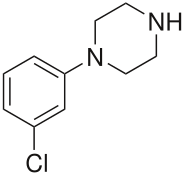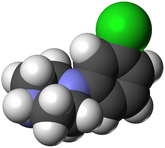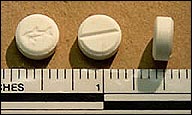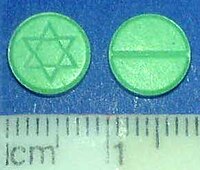 | |
 | |
| Clinical data | |
|---|---|
| Routes of administration | Oral, intranasal, rectal |
| ATC code |
|
| Legal status | |
| Legal status | |
| Pharmacokinetic data | |
| Metabolism | Liver (CYP2D6) |
| Elimination half-life | 4–14 hours |
| Excretion | Urine |
| Identifiers | |
IUPAC name
| |
| CAS Number | |
| PubChem CID | |
| IUPHAR/BPS | |
| ChemSpider | |
| UNII | |
| KEGG | |
| ChEBI | |
| ChEMBL | |
| CompTox Dashboard (EPA) | |
| ECHA InfoCard | 100.026.959 |
| Chemical and physical data | |
| Formula | C10H13ClN2 |
| Molar mass | 196.68 g·mol |
| 3D model (JSmol) | |
SMILES
| |
InChI
| |
| (what is this?) (verify) | |
meta-Chlorophenylpiperazine (mCPP) is a psychoactive drug of the phenylpiperazine class. It was initially developed in the late-1970s and used in scientific research before being sold as a designer drug in the mid-2000s. It has been detected in pills touted as legal alternatives to illicit stimulants in New Zealand and pills sold as "ecstasy" in Europe and the United States.
Despite its advertisement as a recreational substance, mCPP is actually generally considered to be an unpleasant experience and is not desired by drug users. It lacks any reinforcing effects, but has "psychostimulant, anxiety-provoking, and hallucinogenic effects." It is also known to produce dysphoric, depressive, and anxiogenic effects in rodents and humans, and can induce panic attacks in individuals susceptible to them. It also worsens obsessive–compulsive symptoms in people with the disorder.
mCPP is known to induce headaches in humans and has been used for testing potential antimigraine medications. It has potent anorectic effects and has encouraged the development of selective 5-HT2C receptor agonists for the treatment of obesity as well.
Pharmacology
Pharmacodynamics
| Site | Ki (nM) | Species | Refs |
|---|---|---|---|
| SERTTooltip Serotonin transporter | 202–432 | Human | |
| NETTooltip Norepinephrine transporter | 1,940–4,360 | Human | |
| DATTooltip Dopamine transporter | ND | ND | ND |
| 5-HT1A | 44–400 | Human | |
| 5-HT1B | 89–501 | Human | |
| 5-HT1D | 210–1,300 | Human | |
| 5-HT1E | ND | ND | ND |
| 5-HT1F | ND | ND | ND |
| 5-HT2A | 32–398 | Human | |
| 5-HT2B | 3.2–63 | Human | |
| 5-HT2C | 3.4–251 | Human | |
| 5-HT3 | 427 | Human | |
| 5-HT4 | ND | ND | ND |
| 5-HT5A | 1,354 | Human | |
| 5-HT6 | 1,748 | Human | |
| 5-HT7 | 163 | Human | |
| α1 | 97–2,900 | Human | |
| α1A | 1,386 | Human | |
| α1B | 915 | Human | |
| α1D | ND | ND | ND |
| α2 | 112–570 | Human | |
| α2A | 145 | Human | |
| α2B | 106 | Human | |
| α2C | 124 | Human | |
| β | 2,500 | Human | |
| β1 | 2,359 | Human | |
| β2 | 3,474 | Human | |
| D1 | 7,000 | Human | |
| D2 | >10,000 | Human | |
| D3 | >10,000 | Rat | |
| D4 | ND | ND | ND |
| D5 | >10,000 | Human | |
| H1 | 326 | Human | |
| mAChRs | >10,000 | Human | |
| nAChRsTooltip Nicotinic acetylcholine receptors | >10,000 | Human | |
| σ1 | ND | ND | ND |
| σ2 | 8,350 | Rat | |
| I1 | 759 | Rat | |
| VDCCTooltip Voltage-dependent calcium channel | 6,043 | Rat | |
| Values are Ki (nM). The smaller the value, the more strongly the drug binds to the site. | |||
mCPP possesses significant affinity for the 5-HT1A, 5-HT1B, 5-HT1D, 5-HT2A, 5-HT2B, 5-HT2C, 5-HT3, and 5-HT7 receptors, as well as the SERT. It also has some affinity for α1-adrenergic, α2-adrenergic, H1, I1, and NET. It behaves as an agonist at most serotonin receptors. mCPP has been shown to act not only as a serotonin reuptake inhibitor but as a serotonin releasing agent as well.
mCPP's strongest actions are at the 5-HT2B and 5-HT2C receptors and its discriminative cue is mediated primarily by 5-HT2C. Its negative effects such as anxiety, headaches, and appetite loss are likely mediated by its actions on the 5-HT2C receptor. Other effects of mCPP include nausea, hypoactivity, and penile erection, the latter two the result of increased 5-HT2C activity and the former likely via 5-HT3 stimulation.
In comparison studies, mCPP has approximately 10-fold selectivity for the human 5-HT2C receptor over the human 5-HT2A and 5-HT2B receptors (Ki = 3.4 nM vs. 32.1 and 28.8 nM). It acts as a partial agonist of the human 5-HT2A and 5-HT2C receptors but as an antagonist of the human 5-HT2B receptors.
Despite acting as a serotonin 5-HT2A receptor agonist, mCPP has been described as non-hallucinogenic. However, hallucinations have occasionally been reported when large doses of mCPP are taken.
Pharmacokinetics
mCPP is metabolized via the CYP2D6 isoenzyme by hydroxylation to para-hydroxy-mCPP (p-OH-mCPP) and this plays a major role in its metabolism. The elimination half-life of mCPP is 4 to 14 hours.
mCPP is a metabolite of a variety of other piperazine drugs including trazodone, nefazodone, etoperidone, enpiprazole, mepiprazole, cloperidone, peraclopone, and BRL-15,572. It is formed by dealkylation via CYP3A4. Caution should be exercised in concomitant administration of CYP2D6 inhibitors such as bupropion, fluoxetine, paroxetine, and thioridazine with drugs that produce mCPP as a metabolite as these drugs are known to increase concentrations of the parent molecule (e.g., trazodone) and of mCPP.
Chemistry
Analogues
Analogues of mCPP include:
- 1-Benzylpiperazine (BZP)
- 1-Methyl-4-benzylpiperazine (MBZP)
- 1,4-Dibenzylpiperazine (DBZP)
- 3-Trifluoromethylphenylpiperazine (TFMPP)
- 3,4-Methylenedioxy-1-benzylpiperazine (MDBZP)
- 4-Bromo-2,5-dimethoxy-1-benzylpiperazine (2C-B-BZP)
- 4-Fluorophenylpiperazine (pFPP)
- 4-Methoxyphenylpiperazine (MeOPP)
Some additional analogues include quipazine, ORG-12962, and 3C-PEP.
Society and culture


Legal status
Belgium
mCPP is illegal in Belgium.
Brazil
mCPP is illegal in Brazil.
Canada
mCPP is not a controlled drug in Canada.
China
As of October 2015 mCPP is a controlled substance in China.
Czech Republic
mCPP is legal in the Czech Republic.
Denmark
mCPP is illegal in Denmark.
Finland
mCPP is illegal in Finland.
Germany
mCPP is illegal in Germany.
Hungary
mCPP is illegal in Hungary since 2012.
Japan
mCPP is illegal in Japan since 2006.
Netherlands
mCPP is legal in the Netherlands.
New Zealand
Based on the recommendation of the EACD, the New Zealand government has passed legislation which placed BZP, along with the other piperazine derivatives TFMPP, mCPP, pFPP, MeOPP and MBZP, into Class C of the New Zealand Misuse of Drugs Act 1975. A ban was intended to come into effect in New Zealand on December 18, 2007, but the law change did not go through until the following year, and the sale of BZP and the other listed piperazines became illegal in New Zealand as of 1 April 2008. An amnesty for possession and usage of these drugs remained until October 2008, at which point they became completely illegal. However, mCPP is legally used for scientific research.
Norway
mCPP is illegal in Norway.
Russia
mCPP is illegal in Russia.
Sweden
mCPP is illegal in Sweden.
Poland
mCPP is illegal in Poland.
United States
mCPP is not scheduled at the federal level in the United States, but it is possible that it could be considered a controlled substance analog of BZP, in which case purchase, sale, or possession could be prosecuted under the Federal Analog Act.
However, "chlorophenylpiperazine" is a Schedule I controlled substance in the state of Florida making it illegal to buy, sell, or possess in this state.
Turkey
mCPP is illegal in Turkey since 20/05/2009.
See also
References
- Anvisa (2023-07-24). "RDC Nº 804 - Listas de Substâncias Entorpecentes, Psicotrópicas, Precursoras e Outras sob Controle Especial" [Collegiate Board Resolution No. 804 - Lists of Narcotic, Psychotropic, Precursor, and Other Substances under Special Control] (in Brazilian Portuguese). Diário Oficial da União (published 2023-07-25). Archived from the original on 2023-08-27. Retrieved 2023-08-27.
- ^ Rotzinger S, Bourin M, Akimoto Y, Coutts RT, Baker GB (August 1999). "Metabolism of some "second"- and "fourth"-generation antidepressants: iprindole, viloxazine, bupropion, mianserin, maprotiline, trazodone, nefazodone, and venlafaxine". Cellular and Molecular Neurobiology. 19 (4): 427–442. doi:10.1023/a:1006953923305. PMID 10379419. S2CID 19585113.
- Schatzberg AF, Nemeroff CB (2017). The American Psychiatric Association Publishing Textbook of Psychopharmacology, Fifth Edition. American Psychiatric Pub. pp. 460–. ISBN 978-1-58562-523-9.
- Bossong MG, Van Dijk JP, Niesink RJ (December 2005). "Methylone and mCPP, two new drugs of abuse?". Addiction Biology. 10 (4): 321–323. doi:10.1080/13556210500350794. PMID 16318952. S2CID 36169592. Archived from the original on 2013-01-05.
- Lecompte Y, Evrard I, Arditti J (2006). "". Therapie (in French). 61 (6): 523–530. doi:10.2515/therapie:2006093. PMID 17348609.
- ^ Bossong MG, Brunt TM, Van Dijk JP, Rigter SM, Hoek J, Goldschmidt HM, Niesink RJ (September 2010). "mCPP: an undesired addition to the ecstasy market". Journal of Psychopharmacology. 24 (9): 1395–1401. doi:10.1177/0269881109102541. PMID 19304863. S2CID 11186375.
- Vogels N, Brunt TM, Rigter S, van Dijk P, Vervaeke H, Niesink RJ (December 2009). "Content of ecstasy in the Netherlands: 1993-2008". Addiction. 104 (12): 2057–2066. doi:10.1111/j.1360-0443.2009.02707.x. PMID 19804461.
- World Health Organization. "1-(3-chlorophenyl) piperazine (mCPP) - Expert peer review on pre-review report" (PDF). Retrieved 2021-01-12.
- Tancer ME, Johanson CE (December 2001). "The subjective effects of MDMA and mCPP in moderate MDMA users". Drug and Alcohol Dependence. 65 (1): 97–101. doi:10.1016/s0376-8716(01)00146-6. PMID 11714594.
- Tancer M, Johanson CE (October 2003). "Reinforcing, subjective, and physiological effects of MDMA in humans: a comparison with d-amphetamine and mCPP". Drug and Alcohol Dependence. 72 (1): 33–44. doi:10.1016/S0376-8716(03)00172-8. PMID 14563541.
- ^ Nelson DL, Lucaites VL, Wainscott DB, Glennon RA (January 1999). "Comparisons of hallucinogenic phenylisopropylamine binding affinities at cloned human 5-HT2A, -HT(2B) and 5-HT2C receptors". Naunyn-Schmiedeberg's Archives of Pharmacology. 359 (1): 1–6. doi:10.1007/pl00005315. PMID 9933142. S2CID 20150858.
- Rajkumar R, Pandey DK, Mahesh R, Radha R (April 2009). "1-(m-Chlorophenyl)piperazine induces depressogenic-like behaviour in rodents by stimulating the neuronal 5-HT(2A) receptors: proposal of a modified rodent antidepressant assay". European Journal of Pharmacology. 608 (1–3): 32–41. doi:10.1016/j.ejphar.2009.02.041. PMID 19269287.
- ^ Kennett GA, Whitton P, Shah K, Curzon G (May 1989). "Anxiogenic-like effects of mCPP and TFMPP in animal models are opposed by 5-HT1C receptor antagonists". European Journal of Pharmacology. 164 (3): 445–454. doi:10.1016/0014-2999(89)90252-5. PMID 2767117.
- Klein E, Zohar J, Geraci MF, Murphy DL, Uhde TW (November 1991). "Anxiogenic effects of m-CPP in patients with panic disorder: comparison to caffeine's anxiogenic effects". Biological Psychiatry. 30 (10): 973–984. doi:10.1016/0006-3223(91)90119-7. PMID 1756202. S2CID 43010184.
- Charney DS, Woods SW, Goodman WK, Heninger GR (1987). "Serotonin function in anxiety. II. Effects of the serotonin agonist MCPP in panic disorder patients and healthy subjects". Psychopharmacology. 92 (1): 14–24. doi:10.1007/bf00215473. PMID 3110824. S2CID 43079787.
- Van Veen JF, Van der Wee NJ, Fiselier J, Van Vliet IM, Westenberg HG (October 2007). "Behavioural effects of rapid intravenous administration of meta-chlorophenylpiperazine (m-CPP) in patients with generalized social anxiety disorder, panic disorder and healthy controls". European Neuropsychopharmacology. 17 (10): 637–642. doi:10.1016/j.euroneuro.2007.03.005. PMID 17481859. S2CID 41601926.
- van der Wee NJ, Fiselier J, van Megen HJ, Westenberg HG (October 2004). "Behavioural effects of rapid intravenous administration of meta-chlorophenylpiperazine in patients with panic disorder and controls". European Neuropsychopharmacology. 14 (5): 413–417. doi:10.1016/j.euroneuro.2004.01.001. PMID 15336303. S2CID 28987431.
- Hollander E, DeCaria CM, Nitescu A, Gully R, Suckow RF, Cooper TB, et al. (January 1992). "Serotonergic function in obsessive-compulsive disorder. Behavioral and neuroendocrine responses to oral m-chlorophenylpiperazine and fenfluramine in patients and healthy volunteers". Archives of General Psychiatry. 49 (1): 21–28. doi:10.1001/archpsyc.1992.01820010021003. PMID 1728249.
- Broocks A, Pigott TA, Hill JL, Canter S, Grady TA, L'Heureux F, Murphy DL (June 1998). "Acute intravenous administration of ondansetron and m-CPP, alone and in combination, in patients with obsessive-compulsive disorder (OCD): behavioral and biological results". Psychiatry Research. 79 (1): 11–20. doi:10.1016/S0165-1781(98)00029-8. PMID 9676822. S2CID 30339598.
- Pigott TA, Zohar J, Hill JL, Bernstein SE, Grover GN, Zohar-Kadouch RC, Murphy DL (March 1991). "Metergoline blocks the behavioral and neuroendocrine effects of orally administered m-chlorophenylpiperazine in patients with obsessive-compulsive disorder". Biological Psychiatry. 29 (5): 418–426. doi:10.1016/0006-3223(91)90264-M. PMID 2018816. S2CID 37648659.
- Leone M, Attanasio A, Croci D, Filippini G, D'Amico D, Grazzi L, et al. (July 2000). "The serotonergic agent m-chlorophenylpiperazine induces migraine attacks: A controlled study". Neurology. 55 (1): 136–139. doi:10.1212/wnl.55.1.136. PMID 10891925. S2CID 27617431.
- Martin RS, Martin GR (February 2001). "Investigations into migraine pathogenesis: time course for effects of m-CPP, BW723C86 or glyceryl trinitrate on appearance of Fos-like immunoreactivity in rat trigeminal nucleus caudalis (TNC)". Cephalalgia. 21 (1): 46–52. doi:10.1046/j.1468-2982.2001.00157.x. PMID 11298663. S2CID 8471836.
- Petkov VD, Belcheva S, Konstantinova E (December 1995). "Anxiolytic effects of dotarizine, a possible antimigraine drug". Methods and Findings in Experimental and Clinical Pharmacology. 17 (10): 659–668. PMID 9053586.
- ^ Kennett GA, Curzon G (1988). "Evidence that hypophagia induced by mCPP and TFMPP requires 5-HT1C and 5-HT1B receptors; hypophagia induced by RU 24969 only requires 5-HT1B receptors". Psychopharmacology. 96 (1): 93–100. doi:10.1007/BF02431539. PMID 2906446. S2CID 21417374.
- Sargent PA, Sharpley AL, Williams C, Goodall EM, Cowen PJ (October 1997). "5-HT2C receptor activation decreases appetite and body weight in obese subjects". Psychopharmacology. 133 (3): 309–312. doi:10.1007/s002130050407. PMID 9361339. S2CID 7125577. Archived from the original on 2002-01-12.
- Hayashi A, Suzuki M, Sasamata M, Miyata K (March 2005). "Agonist diversity in 5-HT(2C) receptor-mediated weight control in rats". Psychopharmacology. 178 (2–3): 241–249. doi:10.1007/s00213-004-2019-z. PMID 15719229. S2CID 7580231.
- Halford JC, Harrold JA, Boyland EJ, Lawton CL, Blundell JE (2007). "Serotonergic drugs : effects on appetite expression and use for the treatment of obesity". Drugs. 67 (1): 27–55. doi:10.2165/00003495-200767010-00004. PMID 17209663. S2CID 46972692.
- ^ Roth BL, Driscol J. "PDSP Ki Database". Psychoactive Drug Screening Program (PDSP). University of North Carolina at Chapel Hill and the United States National Institute of Mental Health. Retrieved 14 August 2017.
- ^ Owens MJ, Morgan WN, Plott SJ, Nemeroff CB (December 1997). "Neurotransmitter receptor and transporter binding profile of antidepressants and their metabolites". The Journal of Pharmacology and Experimental Therapeutics. 283 (3): 1305–1322. PMID 9400006.
- ^ Hamik A, Peroutka SJ (March 1989). "1-(m-chlorophenyl)piperazine (mCPP) interactions with neurotransmitter receptors in the human brain". Biological Psychiatry. 25 (5): 569–575. doi:10.1016/0006-3223(89)90217-5. PMID 2537663. S2CID 46730665.
- Boess FG, Martin IL (1994). "Molecular biology of 5-HT receptors". Neuropharmacology. 33 (3–4): 275–317. doi:10.1016/0028-3908(94)90059-0. PMID 7984267. S2CID 35553281.
- Hamblin MW, Metcalf MA (August 1991). "Primary structure and functional characterization of a human 5-HT1D-type serotonin receptor". Molecular Pharmacology. 40 (2): 143–148. PMID 1652050.
- ^ Bonhaus DW, Bach C, DeSouza A, Salazar FH, Matsuoka BD, Zuppan P, et al. (June 1995). "The pharmacology and distribution of human 5-hydroxytryptamine2B (5-HT2B) receptor gene products: comparison with 5-HT2A and 5-HT2C receptors". British Journal of Pharmacology. 115 (4): 622–628. doi:10.1111/j.1476-5381.1995.tb14977.x. PMC 1908489. PMID 7582481.
- Rothman RB, Baumann MH, Savage JE, Rauser L, McBride A, Hufeisen SJ, Roth BL (December 2000). "Evidence for possible involvement of 5-HT(2B) receptors in the cardiac valvulopathy associated with fenfluramine and other serotonergic medications". Circulation. 102 (23): 2836–2841. doi:10.1161/01.cir.102.23.2836. PMID 11104741.
- Porter RH, Benwell KR, Lamb H, Malcolm CS, Allen NH, Revell DF, et al. (September 1999). "Functional characterization of agonists at recombinant human 5-HT2A, 5-HT2B and 5-HT2C receptors in CHO-K1 cells". British Journal of Pharmacology. 128 (1): 13–20. doi:10.1038/sj.bjp.0702751. PMC 1571597. PMID 10498829.
- Bentley JM, Adams DR, Bebbington D, Benwell KR, Bickerdike MJ, Davidson JE, et al. (May 2004). "Indoline derivatives as 5-HT(2C) receptor agonists". Bioorganic & Medicinal Chemistry Letters. 14 (9): 2367–2370. doi:10.1016/j.bmcl.2003.05.001. PMID 15081042.
- Silverstone PH, Rue JE, Franklin M, Hallis K, Camplin G, Laver D, Cowen PJ (September 1994). "The effects of administration of mCPP on psychological, cognitive, cardiovascular, hormonal and MHPG measurements in human volunteers". International Clinical Psychopharmacology. 9 (3): 173–178. doi:10.1097/00004850-199409000-00005. PMID 7814826. S2CID 25464507.
- Samanin R, Mennini T, Ferraris A, Bendotti C, Borsini F, Garattini S (August 1979). "Chlorophenylpiperazine: a central serotonin agonist causing powerful anorexia in rats". Naunyn-Schmiedeberg's Archives of Pharmacology. 308 (2): 159–163. doi:10.1007/BF00499059. PMID 503247. S2CID 19293115.
- Odagaki Y, Toyoshima R, Yamauchi T (May 2005). "Trazodone and its active metabolite m-chlorophenylpiperazine as partial agonists at 5-HT1A receptors assessed by GTPgammaS binding". Journal of Psychopharmacology. 19 (3): 235–241. doi:10.1177/0269881105051526. PMID 15888508. S2CID 27389008.
- Pettibone DJ, Williams M (May 1984). "Serotonin-releasing effects of substituted piperazines in vitro". Biochemical Pharmacology. 33 (9): 1531–1535. doi:10.1016/0006-2952(84)90424-6. PMID 6610423.
- Callahan PM, Cunningham KA (May 1994). "Involvement of 5-HT2C receptors in mediating the discriminative stimulus properties of m-chlorophenylpiperazine (mCPP)". European Journal of Pharmacology. 257 (1–2): 27–38. doi:10.1016/0014-2999(94)90690-4. PMID 8082704.
- Gommans J, Hijzen TH, Maes RA, Olivier B (June 1998). "Discriminative stimulus properties of mCPP: evidence for a 5-HT2C receptor mode of action". Psychopharmacology. 137 (3): 292–302. doi:10.1007/s002130050622. PMID 9683007. S2CID 9265150. Archived from the original on 2002-01-12.
- Kennett GA, Curzon G (May 1988). "Evidence that mCPP may have behavioural effects mediated by central 5-HT1C receptors". British Journal of Pharmacology. 94 (1): 137–147. doi:10.1111/j.1476-5381.1988.tb11508.x. PMC 1853919. PMID 3401632.
- Kłodzińska A, Jaros T, Chojnacka-Wójcik E, Maj J (1989). "Exploratory hypoactivity induced by m-trifluoromethylphenylpiperazine (TFMPP) and m-chlorophenylpiperazine (m-CPP)". Journal of Neural Transmission. Parkinson's Disease and Dementia Section. 1 (3): 207–218. doi:10.1007/BF02248670. PMID 2775468. S2CID 23471213.
- Walsh AE, Smith KA, Oldman AD, Williams C, Goodall EM, Cowen PJ (September 1994). "m-Chlorophenylpiperazine decreases food intake in a test meal". Psychopharmacology. 116 (1): 120–122. doi:10.1007/BF02244883. PMID 7862925. S2CID 40801166.
- Stancampiano R, Melis MR, Argiolas A (August 1994). "Penile erection and yawning induced by 5-HT1C receptor agonists in male rats: relationship with dopaminergic and oxytocinergic transmission". European Journal of Pharmacology. 261 (1–2): 149–155. doi:10.1016/0014-2999(94)90313-1. PMID 8001637.
- Grotewiel MS, Chu H, Sanders-Bush E (November 1994). "m-chlorophenylpiperazine and m-trifluoromethylphenylpiperazine are partial agonists at cloned 5-HT2A receptors expressed in fibroblasts". The Journal of Pharmacology and Experimental Therapeutics. 271 (2): 1122–1126. PMID 7965773. Retrieved 2022-10-02.
- Porter RH, Benwell KR, Lamb H, Malcolm CS, Allen NH, Revell DF, et al. (September 1999). "Functional characterization of agonists at recombinant human 5-HT2A, 5-HT2B and 5-HT2C receptors in CHO-K1 cells". British Journal of Pharmacology. 128 (1): 13–20. doi:10.1038/sj.bjp.0702751. PMC 1571597. PMID 10498829.
- Thomas DR, Gager TL, Holland V, Brown AM, Wood MD (June 1996). "m-Chlorophenylpiperazine (mCPP) is an antagonist at the cloned human 5-HT2B receptor". NeuroReport. 7 (9): 1457–1460. doi:10.1097/00001756-199606170-00002. PMID 8856697.
- ^ Gumpper RH, Roth BL (January 2024). "Psychedelics: preclinical insights provide directions for future research". Neuropsychopharmacology. 49 (1): 119–127. doi:10.1038/s41386-023-01567-7. PMID 36932180.
- ^ Rotzinger S, Fang J, Coutts RT, Baker GB (December 1998). "Human CYP2D6 and metabolism of m-chlorophenylpiperazine". Biological Psychiatry. 44 (11): 1185–1191. doi:10.1016/S0006-3223(97)00483-6. PMID 9836023. S2CID 45097940.
- ^ Elliott S (2011). "Current awareness of piperazines: pharmacology and toxicology". Drug Testing and Analysis. 3 (7–8): 430–438. doi:10.1002/dta.307. PMID 21744514.
- "EMCDDA | News". www.emcdda.europa.eu.
- "ANVISA resolution - Portaria SVS/MS 344/98".
- "关于印发《非药用类麻醉药品和精神药品列管办法》的通知" (in Chinese). China Food and Drug Administration. 27 September 2015. Archived from the original on 1 October 2015. Retrieved 1 October 2015.
- "Legislativa". www.mzcr.cz.
- "Erowid Psychoactive Vaults : Law : Countries : Denmark (DK) : Denmark bans 2C-T-4, TFMPP, BZP, mCPP, MeOPP". www.erowid.org.
- Koninkrijksrelaties, Ministerie van Binnenlandse Zaken en. "Opiumwet". wetten.overheid.nl.
- "Misuse of Drugs (Classification of BZP) Amendment Bill 2008".
- "21 CFR — SCHEDULES OF CONTROLLED SUBSTANCES §1308.11 Schedule I." Archived from the original on 2009-08-27. Retrieved 2014-12-18.
- "Statutes & Constitution :View Statutes : Online Sunshine". leg.state.fl.us.
- "Başbakanlık Mevzuatı Geliştirme ve Yayın Genel Müdürlüğü".
External links
 Media related to Meta-Chlorophenylpiperazine at Wikimedia Commons
Media related to Meta-Chlorophenylpiperazine at Wikimedia Commons
| Monoamine releasing agents | |||||||||||||||
|---|---|---|---|---|---|---|---|---|---|---|---|---|---|---|---|
| DRAsTooltip Dopamine releasing agents |
| ||||||||||||||
| NRAsTooltip Norepinephrine releasing agents |
| ||||||||||||||
| SRAsTooltip Serotonin releasing agents |
| ||||||||||||||
| Others |
| ||||||||||||||
| See also: Receptor/signaling modulators • Monoamine reuptake inhibitors • Adrenergics • Dopaminergics • Serotonergics • Monoamine metabolism modulators • Monoamine neurotoxins | |||||||||||||||
| Serotonin receptor modulators | |||||||||||||||||||||||||||||||||||||||
|---|---|---|---|---|---|---|---|---|---|---|---|---|---|---|---|---|---|---|---|---|---|---|---|---|---|---|---|---|---|---|---|---|---|---|---|---|---|---|---|
| 5-HT1 |
| ||||||||||||||||||||||||||||||||||||||
| 5-HT2 |
| ||||||||||||||||||||||||||||||||||||||
| 5-HT3–7 |
| ||||||||||||||||||||||||||||||||||||||
- Drugs not assigned an ATC code
- 3-Chlorophenyl compounds
- 5-HT2A agonists
- 5-HT2B antagonists
- 5-HT2C agonists
- Alpha-1 blockers
- Alpha-2 blockers
- Anxiogenics
- Designer drugs
- Human drug metabolites
- Meta-Chlorophenylpiperazines
- Non-hallucinogenic 5-HT2A receptor agonists
- Serotonin receptor agonists
- Serotonin releasing agents
- Stimulants